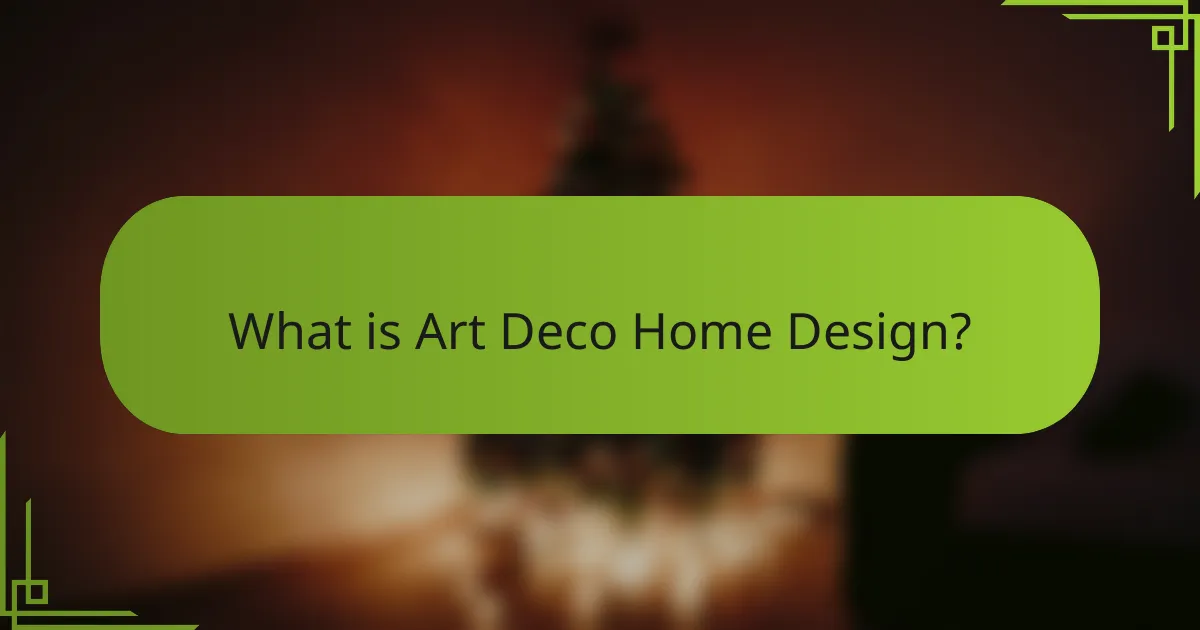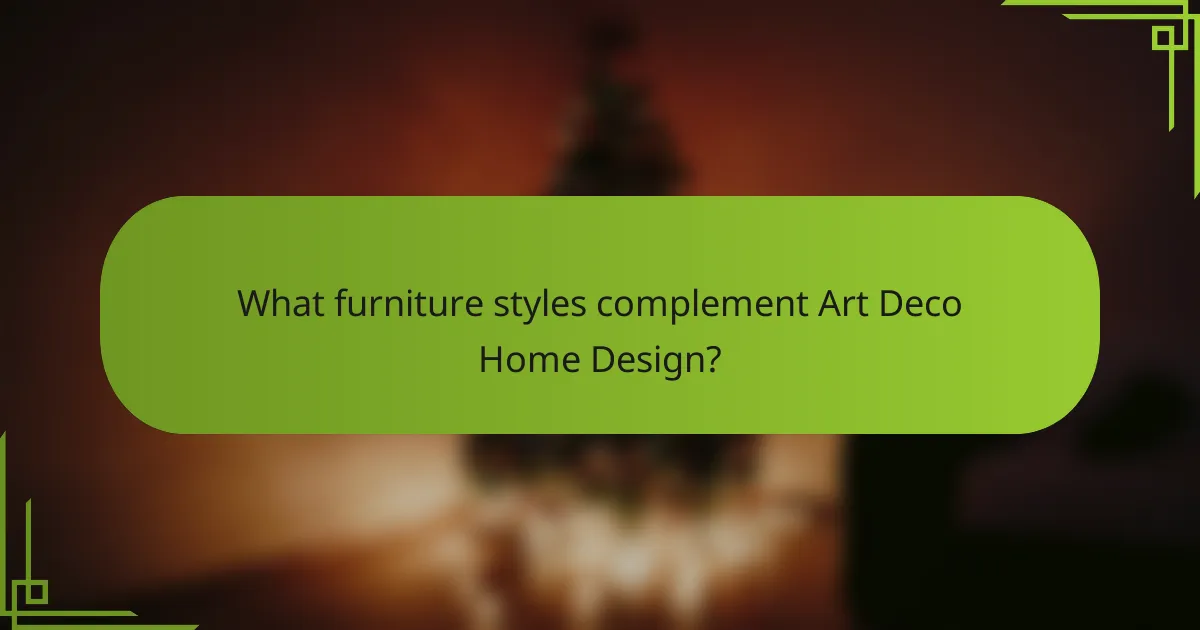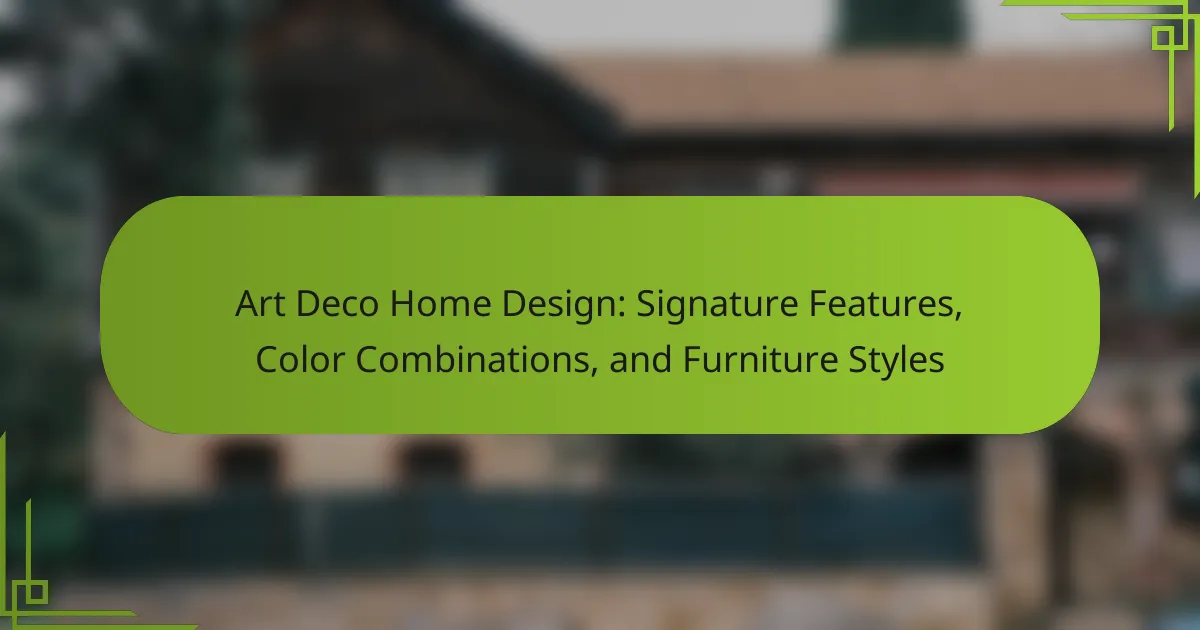
What is Art Deco Home Design?
Art Deco home design is a style that emerged in the 1920s and 1930s. It is characterized by bold geometric shapes and vibrant colors. This design movement integrates luxurious materials like chrome, glass, and exotic woods. Art Deco often features intricate patterns and ornamental details. It reflects a sense of glamour and modernity. The style was influenced by various artistic movements, including Cubism and Futurism. Notable examples of Art Deco architecture include the Chrysler Building in New York. This design remains popular for its elegance and distinctive aesthetic.
How did Art Deco Home Design emerge as a style?
Art Deco Home Design emerged in the 1920s as a response to the ornate styles of the previous era. It incorporated modern materials and geometric shapes. The style was influenced by the 1925 International Exposition of Modern Decorative and Industrial Arts in Paris. This event showcased the latest trends in architecture and design. Art Deco emphasized luxury, glamour, and technological progress. It drew inspiration from various sources, including Cubism and Futurism. The style gained popularity in the United States during the 1930s. Iconic buildings and interiors reflected its vibrant colors and bold patterns.
What historical influences shaped Art Deco Home Design?
Art Deco Home Design was shaped by several historical influences. The movement emerged in the 1920s and 1930s, reflecting the optimism of the post-World War I era. Industrialization played a significant role, as new materials like steel and glass became widely available. The rise of the Jazz Age influenced the style’s vibrant colors and dynamic forms. Additionally, the 1925 Exposition Internationale des Arts Décoratifs et Industriels Modernes in Paris showcased the Art Deco style to a global audience. Influences from ancient cultures, particularly Egyptian and Aztec art, also contributed to its unique aesthetic. The combination of these elements created a distinctive design movement characterized by luxury and modernity.
What are the defining characteristics of Art Deco Home Design?
Art Deco Home Design is characterized by bold geometric shapes, rich colors, and luxurious materials. The style emerged in the 1920s and 1930s, reflecting modernity and elegance. Common elements include streamlined forms and symmetrical patterns. Decorative motifs often feature zigzags, chevrons, and sunburst designs. Materials like chrome, glass, and exotic woods are frequently used. Art Deco also emphasizes craftsmanship and intricate detailing. The color palette typically includes deep hues like emerald green, royal blue, and gold accents. This design style evokes a sense of glamour and sophistication, making it timeless.
What are the signature features of Art Deco Home Design?
Art Deco home design is characterized by bold geometric shapes, rich colors, and luxurious materials. This style emerged in the 1920s and 1930s, reflecting the optimism of the era. Signature features include streamlined forms and symmetrical designs. Art Deco often incorporates motifs inspired by nature, such as flowers and animals, rendered in stylized ways. Decorative elements like zigzags and chevrons are commonly used. The use of materials such as chrome, glass, and exotic woods enhances the opulence of Art Deco interiors. Lighting fixtures often feature intricate designs, emphasizing elegance. Overall, Art Deco design blends functionality with artistic expression, creating visually striking spaces.
How do geometric shapes play a role in Art Deco aesthetics?
Geometric shapes are fundamental to Art Deco aesthetics. They create a sense of order and symmetry. This style features bold, angular lines and streamlined forms. Common shapes include zigzags, chevrons, and sunbursts. These shapes convey modernity and elegance. Art Deco emerged in the 1920s and 1930s, reflecting the era’s fascination with technology and progress. The use of geometric patterns can be seen in architecture, furniture, and decorative arts. This emphasis on geometry distinguishes Art Deco from previous artistic movements.
What materials are commonly used in Art Deco Home Design?
Common materials used in Art Deco home design include glass, chrome, and exotic woods. Glass is often utilized in decorative elements and lighting fixtures. Chrome provides a sleek, modern finish to furniture and accents. Exotic woods like mahogany and walnut add richness and warmth to interiors. Additionally, materials such as marble and ceramics are frequently incorporated for their luxurious appearance. These materials reflect the opulence and geometric patterns characteristic of the Art Deco style.
How does ornamentation enhance Art Deco interiors?
Ornamentation enhances Art Deco interiors by adding visual richness and sophistication. This style is characterized by bold geometric shapes and intricate patterns. Decorative elements such as mirrors, metallic finishes, and stylized motifs create a sense of luxury. The use of materials like chrome, glass, and exotic woods contributes to a lavish aesthetic. Ornamentation also emphasizes symmetry and balance, which are key principles in Art Deco design. Historical examples include the Chrysler Building, showcasing elaborate ornamentation that elevates its architectural presence. Overall, ornamentation is essential in defining the unique character of Art Deco interiors.
What color combinations are typical in Art Deco Home Design?
Art Deco home design typically features bold color combinations. Common pairings include black and gold, which evoke luxury and sophistication. Another popular combination is deep blue and silver, creating a striking visual contrast. Rich jewel tones like emerald green and ruby red are also frequently used. These colors often appear alongside neutral shades like cream or beige to balance the overall palette. The use of metallics, particularly chrome and brass, enhances the glamorous feel of Art Deco interiors. Historical context shows that these combinations reflect the opulence of the 1920s and 1930s, emphasizing geometric patterns and luxurious materials.
What are the most popular color palettes used in Art Deco?
The most popular color palettes used in Art Deco include bold and vibrant combinations. Common colors are rich jewel tones, such as emerald green, sapphire blue, and ruby red. Metallics like gold and silver are often used to accent these colors. Black and white provide a striking contrast in many Art Deco designs. Pastel shades, including soft pinks and blues, are also prevalent in some interpretations. Geometric patterns often feature these colors prominently. The use of color in Art Deco reflects luxury and elegance. Historical examples, such as the Chrysler Building, showcase these palettes effectively.
How do colors influence the mood of an Art Deco space?
Colors significantly influence the mood of an Art Deco space. Bright, bold colors like deep blues, rich greens, and vibrant reds evoke energy and sophistication. In contrast, softer pastels can create a calming atmosphere. Art Deco design often features geometric patterns, which can amplify the emotional impact of color. Historical examples show that the use of gold and silver accents adds a sense of luxury. The interplay of light and color in Art Deco spaces enhances the overall ambiance. Studies indicate that color psychology plays a crucial role in how individuals perceive their environment. Therefore, choosing the right colors is essential for setting the desired mood in an Art Deco setting.
What are the effects of metallic finishes in Art Deco color schemes?
Metallic finishes in Art Deco color schemes create a sense of luxury and sophistication. These finishes reflect light, enhancing the overall vibrancy of the color palette. Common metallics used include gold, silver, and chrome. Their reflective properties help to amplify the visual impact of bold colors typical in Art Deco designs.
The combination of metallics with rich hues creates striking contrasts. This effect adds depth and dimension to spaces. Historically, the use of metallic finishes was popularized in the 1920s and 1930s, aligning with the opulence of the Art Deco movement. The integration of metallic elements also signifies modernity and innovation in design, resonating with the era’s aesthetic values.

What furniture styles complement Art Deco Home Design?
Mid-century modern, contemporary, and industrial styles complement Art Deco home design. Mid-century modern furniture features clean lines and organic shapes, which pair well with Art Deco’s geometric forms. Contemporary furniture offers sleek designs that harmonize with the luxurious finishes of Art Deco. Industrial styles provide a contrast with raw materials, enhancing the opulence of Art Deco elements. These combinations create a balanced aesthetic, showcasing the elegance of Art Deco while integrating modern sensibilities.
How does Art Deco furniture differ from other styles?
Art Deco furniture is characterized by its bold geometric shapes and luxurious materials. Unlike other styles, it emphasizes symmetry and streamlined forms. Art Deco often incorporates rich colors and intricate patterns, setting it apart from more minimalist styles. Materials like chrome, glass, and exotic woods are commonly used, showcasing opulence. This style emerged in the 1920s and 1930s, reflecting the era’s fascination with modernity and technology. In contrast, traditional styles focus on ornate details and historical references. The use of vibrant colors and metallic finishes in Art Deco furniture creates a striking visual impact. Overall, Art Deco furniture combines elegance with a sense of modernity, distinguishing it from other design movements.
What are the key materials and finishes used in Art Deco furniture?
Key materials used in Art Deco furniture include wood, metal, glass, and leather. Common wood types are walnut and mahogany, valued for their rich colors and textures. Metals like chrome and brass provide a sleek, modern look. Glass is often used in tabletops and decorative elements, featuring geometric patterns. Leather is frequently employed for upholstery, showcasing luxurious finishes. Finishes such as high-gloss lacquers and polished surfaces enhance the visual appeal. These materials and finishes contribute to the distinctive aesthetic of Art Deco furniture, characterized by elegance and sophistication.
Which iconic furniture pieces are associated with Art Deco?
Iconic furniture pieces associated with Art Deco include the Émile-Jacques Ruhlmann armchair, the Jacques-Émile Ruhlmann sideboard, and the Paul Follot coffee table. The Émile-Jacques Ruhlmann armchair is known for its luxurious materials and geometric shapes. The Jacques-Émile Ruhlmann sideboard features intricate inlays and elegant lines. The Paul Follot coffee table showcases bold, streamlined designs typical of the Art Deco movement. These pieces reflect the style’s emphasis on glamour, modernity, and craftsmanship. Art Deco furniture often incorporates exotic woods, polished metals, and bold colors, enhancing their iconic status.
What role does furniture layout play in Art Deco design?
Furniture layout is crucial in Art Deco design as it emphasizes symmetry and functionality. This design style often features geometric shapes and streamlined forms. Arranging furniture in balanced configurations enhances the aesthetic appeal. The layout also facilitates movement and interaction within the space. Art Deco furniture typically includes bold colors and luxurious materials. Proper placement highlights these elements effectively. Historical examples show that iconic Art Deco interiors prioritize spatial organization. This organization contributes to the overall elegance and sophistication of the design.
How can furniture arrangement enhance the Art Deco aesthetic?
Furniture arrangement can enhance the Art Deco aesthetic by emphasizing geometric shapes and symmetry. This design style values bold lines and structured layouts. Arranging furniture in a way that highlights these elements creates a cohesive look. For instance, placing a prominent sofa opposite a sleek coffee table emphasizes balance. Additionally, using mirrored surfaces can reflect light and enhance the luxurious feel typical of Art Deco. Strategic placement of furniture can also draw attention to decorative features, such as intricate moldings or vibrant artworks. Overall, thoughtful furniture arrangement reinforces the elegance and sophistication of the Art Deco style.
What are some tips for selecting Art Deco furniture for your home?
Select Art Deco furniture by focusing on geometric shapes and bold colors. Look for materials like chrome, glass, and exotic woods. Ensure the furniture has streamlined forms and a sense of elegance. Pay attention to intricate details, such as inlays or stylized motifs. Consider the scale of the pieces in relation to your space. Balance is key; mix statement items with simpler designs. Research authentic pieces to avoid reproductions. Finally, ensure that the furniture aligns with your overall design theme for a cohesive look.

How can you incorporate Art Deco elements into modern home design?
Incorporating Art Deco elements into modern home design can be achieved through specific design choices. Use geometric patterns in wallpapers or textiles to reflect the Art Deco style. Incorporate bold colors like deep blues, golds, and rich greens, which are signature to this design era. Choose furniture with streamlined shapes and luxurious materials, such as chrome or glass. Add decorative accents like mirrors with geometric designs to enhance the elegance of the space. Lighting fixtures should feature chrome or brass finishes, often with intricate designs. Art Deco artwork, like sculptures or paintings, can serve as focal points in rooms. Finally, integrate vintage pieces or replicas to maintain authenticity while blending with modern aesthetics.
What are practical tips for blending Art Deco with contemporary styles?
To blend Art Deco with contemporary styles, start by selecting a color palette that harmonizes both aesthetics. Use bold colors typical of Art Deco alongside neutral tones found in contemporary design. Incorporate geometric patterns, which are a hallmark of Art Deco, into modern textiles or wall art. Mix furniture styles by pairing sleek contemporary pieces with vintage Art Deco accents. Utilize materials like glass, chrome, and rich woods, which are common in both styles. Lighting plays a crucial role; choose contemporary fixtures that feature Art Deco elements. Lastly, maintain balance by not overwhelming the space with too many contrasting styles. This approach creates a cohesive look that respects both design traditions.
How can you choose Art Deco-inspired decor for a modern space?
To choose Art Deco-inspired decor for a modern space, select geometric patterns and bold colors. Art Deco is characterized by its luxurious materials and intricate designs. Incorporate metallic finishes such as gold or chrome for a glamorous touch. Use furniture with clean lines and elegant shapes to maintain a modern aesthetic. Choose textiles featuring rich fabrics like velvet or silk for added texture. Incorporate artwork that reflects the era’s style, like abstract sculptures or vibrant paintings. Lighting fixtures should be statement pieces, such as chandeliers with geometric designs. Finally, balance the decor by mixing Art Deco elements with contemporary pieces to create a cohesive look.
What common mistakes should be avoided when designing with Art Deco elements?
Common mistakes to avoid when designing with Art Deco elements include overusing ornate details. Art Deco is characterized by geometric shapes and streamlined forms. Excessive embellishments can detract from its elegance. Another mistake is neglecting color balance. Art Deco often features bold colors paired with neutral tones. Failing to maintain this balance can lead to a chaotic look. Additionally, mixing too many styles can confuse the design. Art Deco should maintain a cohesive aesthetic. Using modern materials that clash with traditional Art Deco can also undermine the design’s authenticity. Stick to materials like chrome, glass, and rich woods. Lastly, ignoring proportion and scale can lead to awkward spaces. Art Deco design relies on symmetry and proportion for visual harmony.
What resources are available for learning more about Art Deco Home Design?
Books on Art Deco design provide in-depth knowledge. “Art Deco: 1910-1939” by Patricia Bayer is a comprehensive resource. Online platforms like the Museum of Modern Art offer digital exhibitions. Websites such as Architectural Digest feature articles on Art Deco styles. Documentaries, like “The Art Deco Movement,” explore its historical context. Social media groups focus on Art Deco enthusiasts sharing insights. Local libraries often have archives on design history. These resources collectively enhance understanding of Art Deco home design.
Where can you find inspiration for Art Deco design projects?
Inspiration for Art Deco design projects can be found in various sources. Notable locations include museums that showcase Art Deco architecture and artifacts. The Art Deco Museum in Miami Beach is a prime example. Books on Art Deco design provide visual references and historical context. Websites dedicated to design trends often feature Art Deco styles. Social media platforms, particularly Pinterest and Instagram, are rich with contemporary interpretations. Architectural magazines frequently highlight Art Deco influences in modern projects. Finally, attending design exhibitions can also spark creativity and provide networking opportunities.
What are some recommended books or websites on Art Deco Home Design?
Recommended books on Art Deco Home Design include “Art Deco Interiors” by David J. H. Jones and “Art Deco Furniture” by Alastair Duncan. Websites such as Architectural Digest and The Spruce offer extensive articles on Art Deco design principles and examples. These sources provide historical context and visual inspiration for enthusiasts. They cover key elements of Art Deco, including signature features, color combinations, and furniture styles.
Art Deco Home Design is a distinctive style that emerged in the 1920s and 1930s, characterized by bold geometric shapes, vibrant colors, and luxurious materials such as chrome and glass. The article explores the historical influences that shaped this design movement, including the impact of the Jazz Age and the 1925 International Exposition in Paris. Key features of Art Deco include intricate ornamentation, rich color palettes, and specific furniture styles that emphasize elegance and modernity. The discussion also covers practical tips for incorporating Art Deco elements into contemporary spaces, avoiding common design mistakes, and resources for further learning about this iconic design style.
